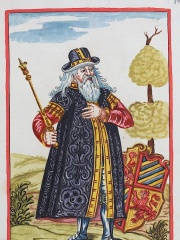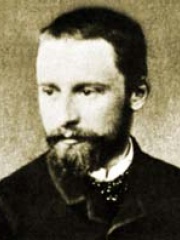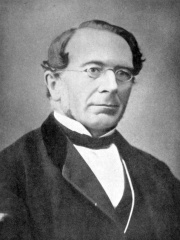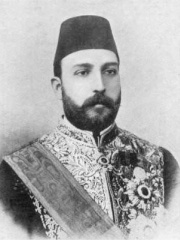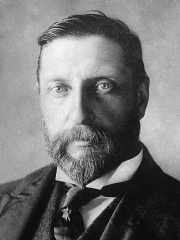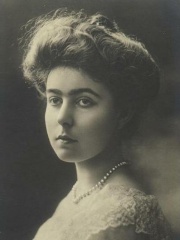NOBLEMAN
Prince Albert Victor, Duke of Clarence and Avondale
1864 - 1892
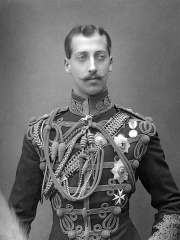
 Prince Albert Victor, Duke of Clarence and Avondale
Prince Albert Victor, Duke of Clarence and Avondale
Prince Albert Victor, Duke of Clarence and Avondale (Albert Victor Christian Edward; 8 January 1864 – 14 January 1892), was the eldest child of the Prince and Princess of Wales (later King Edward VII and Queen Alexandra). From the time of his birth, he was second in the line of succession to the British throne, but did not become king or Prince of Wales because he died before both his father and paternal grandmother Queen Victoria. Albert Victor was known to his family, and many later biographers, as "Eddy". When he was young, he travelled the world extensively as a Royal Navy cadet, and as an adult, he joined the British Army, but did not undertake any active military duties. Read more on Wikipedia
His biography is available in 37 different languages on Wikipedia (up from 35 in 2024). Prince Albert Victor, Duke of Clarence and Avondale is the 225th most popular nobleman (down from 186th in 2024), the 846th most popular biography from United Kingdom (down from 627th in 2019) and the 32nd most popular British Nobleman.
Prince Albert Victor, Duke of Clarence and Avondale, was the eldest son of the Prince of Wales and heir apparent to the British throne from 1892 until his death in 1892. He was known to his family as "Eddy."
Memorability Metrics
Page views of Prince Albert Victor, Duke of Clarence and Avondale by language
Among NOBLEMEN
Among noblemen, Prince Albert Victor, Duke of Clarence and Avondale ranks 225 out of 1,415. Before him are Archduchess Anna of Austria, Christina of Denmark, Agnes of Waiblingen, Cynegils, Laurent de Gouvion Saint-Cyr, and Elizabeth of Denmark, Duchess of Mecklenburg. After him are Guntram the Rich, Stéphanie de Beauharnais, Ercole I d'Este, Duke of Ferrara, Anna Maria Luisa de' Medici, Frederick VI, Duke of Swabia, and Landgravine Elisabeth Amalie of Hesse-Darmstadt.
Most Popular Noblemen in Wikipedia
Go to all RankingsArchduchess Anna of Austria
1528 - 1590
HPI: 68.95
Rank: 219
Christina of Denmark
1521 - 1590
HPI: 68.79
Rank: 220
Agnes of Waiblingen
1072 - 1143
HPI: 68.74
Rank: 221
Cynegils
575 - 642
HPI: 68.73
Rank: 222
Laurent de Gouvion Saint-Cyr
1764 - 1830
HPI: 68.73
Rank: 223
Elizabeth of Denmark, Duchess of Mecklenburg
1524 - 1586
HPI: 68.73
Rank: 224
Prince Albert Victor, Duke of Clarence and Avondale
1864 - 1892
HPI: 68.73
Rank: 225
Guntram the Rich
920 - 973
HPI: 68.72
Rank: 226
Stéphanie de Beauharnais
1789 - 1860
HPI: 68.71
Rank: 227
Ercole I d'Este, Duke of Ferrara
1431 - 1505
HPI: 68.52
Rank: 228
Anna Maria Luisa de' Medici
1667 - 1743
HPI: 68.52
Rank: 229
Frederick VI, Duke of Swabia
1167 - 1191
HPI: 68.52
Rank: 230
Landgravine Elisabeth Amalie of Hesse-Darmstadt
1635 - 1709
HPI: 68.47
Rank: 231
Contemporaries
Among people born in 1864, Prince Albert Victor, Duke of Clarence and Avondale ranks 23. Before him are Charles Cooley, Yun Chi-ho, Wilhelm Karl, Duke of Urach, Alexej von Jawlensky, Heinrich Wölfflin, and Vilhelm Hammershøi. After him are Paul Sérusier, John Jacob Astor IV, Jules Renard, Eugen d'Albert, Frank Wedekind, and Rudolf Kjellén. Among people deceased in 1892, Prince Albert Victor, Duke of Clarence and Avondale ranks 16. Before him are Louis IV, Grand Duke of Hesse, Rudolf von Jhering, Annibale de Gasparis, Louis Vuitton, Grand Duke Konstantin Nikolayevich of Russia, and Deodoro da Fonseca. After him are Alfred, Lord Tennyson, August Wilhelm von Hofmann, Henry Walter Bates, Thomas Cook, Tewfik Pasha, and Charles Spurgeon.
Others Born in 1864
Go to all RankingsCharles Cooley
ECONOMIST
1864 - 1929
HPI: 73.19
Rank: 17
Yun Chi-ho
SOCIAL ACTIVIST
1864 - 1945
HPI: 71.56
Rank: 18
Wilhelm Karl, Duke of Urach
POLITICIAN
1864 - 1928
HPI: 71.40
Rank: 19
Alexej von Jawlensky
PAINTER
1864 - 1941
HPI: 71.13
Rank: 20
Heinrich Wölfflin
HISTORIAN
1864 - 1945
HPI: 70.43
Rank: 21
Vilhelm Hammershøi
PAINTER
1864 - 1916
HPI: 70.30
Rank: 22
Prince Albert Victor, Duke of Clarence and Avondale
NOBLEMAN
1864 - 1892
HPI: 68.73
Rank: 23
Paul Sérusier
PAINTER
1864 - 1927
HPI: 68.66
Rank: 24
John Jacob Astor IV
WRITER
1864 - 1912
HPI: 68.59
Rank: 25
Jules Renard
WRITER
1864 - 1910
HPI: 68.51
Rank: 26
Eugen d'Albert
COMPOSER
1864 - 1932
HPI: 68.45
Rank: 27
Frank Wedekind
WRITER
1864 - 1918
HPI: 68.40
Rank: 28
Rudolf Kjellén
POLITICIAN
1864 - 1922
HPI: 68.40
Rank: 29
Others Deceased in 1892
Go to all RankingsLouis IV, Grand Duke of Hesse
POLITICIAN
1837 - 1892
HPI: 71.49
Rank: 10
Rudolf von Jhering
LAWYER
1818 - 1892
HPI: 71.04
Rank: 11
Annibale de Gasparis
ASTRONOMER
1819 - 1892
HPI: 70.60
Rank: 12
Louis Vuitton
BUSINESSPERSON
1821 - 1892
HPI: 69.49
Rank: 13
Grand Duke Konstantin Nikolayevich of Russia
NOBLEMAN
1827 - 1892
HPI: 69.19
Rank: 14
Deodoro da Fonseca
POLITICIAN
1827 - 1892
HPI: 68.92
Rank: 15
Prince Albert Victor, Duke of Clarence and Avondale
NOBLEMAN
1864 - 1892
HPI: 68.73
Rank: 16
Alfred, Lord Tennyson
WRITER
1809 - 1892
HPI: 68.54
Rank: 17
August Wilhelm von Hofmann
CHEMIST
1818 - 1892
HPI: 68.38
Rank: 18
Henry Walter Bates
BIOLOGIST
1825 - 1892
HPI: 68.16
Rank: 19
Thomas Cook
BUSINESSPERSON
1808 - 1892
HPI: 68.03
Rank: 20
Tewfik Pasha
POLITICIAN
1852 - 1892
HPI: 67.81
Rank: 21
Charles Spurgeon
RELIGIOUS FIGURE
1834 - 1892
HPI: 67.74
Rank: 22
In United Kingdom
Among people born in United Kingdom, Prince Albert Victor, Duke of Clarence and Avondale ranks 846 out of 8,785. Before him are Ernest Thompson Seton (1860), Eleanor Marx (1855), Wilkie Collins (1824), John Newlands (1837), Cynegils (575), and Sir Arthur Harris, 1st Baronet (1892). After him are Cecily Neville, Duchess of York (1415), Samuel Richardson (1689), Eadwig (940), Sawney Bean (1600), Daniel Rutherford (1749), and H. Rider Haggard (1856).
Others born in United Kingdom
Go to all RankingsErnest Thompson Seton
WRITER
1860 - 1946
HPI: 68.77
Rank: 840
Eleanor Marx
WRITER
1855 - 1898
HPI: 68.76
Rank: 841
Wilkie Collins
WRITER
1824 - 1889
HPI: 68.76
Rank: 842
John Newlands
CHEMIST
1837 - 1898
HPI: 68.74
Rank: 843
Cynegils
NOBLEMAN
575 - 642
HPI: 68.73
Rank: 844
Sir Arthur Harris, 1st Baronet
PILOT
1892 - 1984
HPI: 68.73
Rank: 845
Prince Albert Victor, Duke of Clarence and Avondale
NOBLEMAN
1864 - 1892
HPI: 68.73
Rank: 846
Cecily Neville, Duchess of York
POLITICIAN
1415 - 1495
HPI: 68.73
Rank: 847
Samuel Richardson
WRITER
1689 - 1761
HPI: 68.72
Rank: 848
Eadwig
POLITICIAN
940 - 959
HPI: 68.72
Rank: 849
Sawney Bean
EXTREMIST
1600 - 1600
HPI: 68.72
Rank: 850
Daniel Rutherford
PHYSICIST
1749 - 1819
HPI: 68.70
Rank: 851
H. Rider Haggard
WRITER
1856 - 1925
HPI: 68.70
Rank: 852
Among NOBLEMEN In United Kingdom
Among noblemen born in United Kingdom, Prince Albert Victor, Duke of Clarence and Avondale ranks 32. Before him are Jasper Tudor (1431), Prince Andrew, Duke of York (1960), Prince Harry, Duke of Sussex (1984), Princess Margaret of Connaught (1882), Lady Katherine Grey (1540), and Cynegils (575). After him are Henry, Duke of Cornwall (1511), Edmund Tudor, Duke of Somerset (1499), Katherine Woodville, Duchess of Buckingham (1458), Princess Maud, Countess of Southesk (1893), Prince John of the United Kingdom (1905), and Isabella of England (1214).
Jasper Tudor
1431 - 1495
HPI: 72.42
Rank: 26
Prince Andrew, Duke of York
1960 - Present
HPI: 72.16
Rank: 27
Prince Harry, Duke of Sussex
1984 - Present
HPI: 71.81
Rank: 28
Princess Margaret of Connaught
1882 - 1920
HPI: 71.68
Rank: 29
Lady Katherine Grey
1540 - 1568
HPI: 70.25
Rank: 30
Cynegils
575 - 642
HPI: 68.73
Rank: 31
Prince Albert Victor, Duke of Clarence and Avondale
1864 - 1892
HPI: 68.73
Rank: 32
Henry, Duke of Cornwall
1511 - Present
HPI: 68.31
Rank: 33
Edmund Tudor, Duke of Somerset
1499 - 1500
HPI: 68.11
Rank: 34
Katherine Woodville, Duchess of Buckingham
1458 - 1497
HPI: 67.22
Rank: 35
Princess Maud, Countess of Southesk
1893 - 1945
HPI: 66.62
Rank: 36
Prince John of the United Kingdom
1905 - 1919
HPI: 66.46
Rank: 37
Isabella of England
1214 - 1241
HPI: 66.15
Rank: 38






